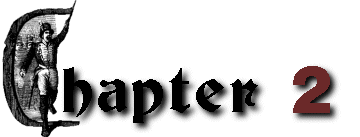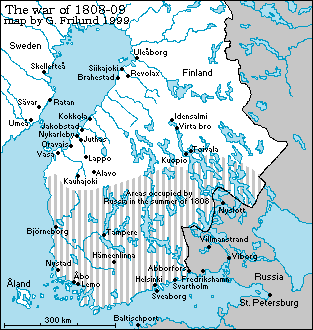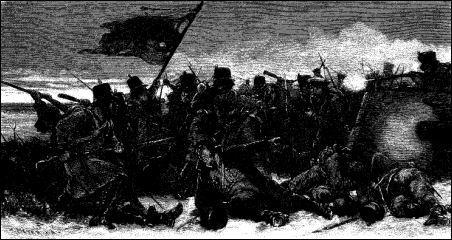
The military operations of the war of 1808-09
The Swedish plan of war was simple enough and had been designed so that the fortifications at Sveaborg ("The Gibraltar of the north") could come to full use. The Swedish high command planned to move the land armies north, up into Finland, in retreat and there await reinforcements from Sweden itself. It was believed that the Russian armies of invasion would have their hands full trying to conquer the forts at Sveaborg and Svartholm, and especially Sveaborg was considered strong enough to keep up a significant threat in the back of the Russian armies. It was also planned that the Swedish coastal fleet should harass the Russians with landings of troops on vital points on occupied territory. Sveaborg was the largest base for the coastal fleet. Thus, Sveaborg was the key to Finland.
 The first retreat
The first retreat
As the war had now begun, general Carl Nathanael af Klercker collected the Swedish army in Finland to Hämeenlinna (Tavastehus), but when the high commander of the army, fieldmarshal Wilhelm Mauritz Klingspor, arrived from Sweden on March 1, 1808, the order of retreat north was given. The army of Finland thus retreated, all according to plan, leaving southern Finland to Russian occupation. Strong garrisons were posted at Sveaborg and Svartholm. However, during the retreat north, the Swedish army did not even once try to delay the Russian offensive, instead the retreat looked like it was a defeated army escaping a victorious one. The Russians took Helsinki on March 2, Svartholm surrendered for the attacking armies on March 18 and Åbo, the age-old capital of Finland, was taken on March 22. All apart from Sveaborg, southern Finland was occupied.
The retreating Swedes were now up in Österbotten, on the west coast of Finland. The warfare was rather unpopular though as the soldiers were reluctant to leave their homes and families behind without a fight. The Russian troops following the Swedish army were at this moment getting more aggressive. On April 16, a skirmish was fought in Pyhäjoki, where the Swedish troops repelled two attacks made by the Russians under Kulnev. The Swedish commander, Georg Carl von Döbeln, gave the order of retreat though, as this was part of Klingspor's initial plan.
On April 17 both armies rested. On this day Carl Johan Adlercreutz was made second in command to Wilhelm Mauritz Klingspor. While the retreat had been bad for the morale among the Swedish troops, the men were longing for the first fight. And it came sooner than expected.
On April 18 Klingspor's army again marched off north towards Siikajoki, closely followed by Russian cossacks. Jakov Petrovitj Kulnev, who was as always very aggressive, again took his chance and attacked the Swedes at Siikajoki. In a bloody engagement, the Swedish were able to fend off the Russian advances though. At this time the fighting was getting interesting as the Swedish army was starting to show interest. On April 27, Adlercreutz beat off the Russians again at Revolax. In the end phase of Revolax, some the Russians had taken position inside a building, which was attacked by the Swedish. Although these fights had been small, the meaning they had for the Swedish morale was far more important. The Russians were also at this moment having a hard time holding together their campaign - their supply lines were stretched to the utmost. Large parts of the Russian army were held up at Sveaborg and the Finnish civilian population were showing an increased disappointment in the Russian occupation. Peasants rebellions and guerilla groups started working in the back of the Russian army, threatening their vulnerable supply lines. It soon stood clear that the original 24.000 Russian troops that were operating in Finland would not be enough. The Swedish retreat had come to an end though.
For continued understanding of the war that took place, I will go through the three different theatres of war and mention a few words about each. As you may already understand, warfare in Scandinavia did not look like anything on the continent, and this disappointed the Russian high command that had planned a quick and decisive lightning-war in Napoleonic style. Due to the terrain in Finland; with large, dark woods where movements of large armies was on the brink of impossible, and long distances between villages towns and dwellings, the war was mainly fought along the main roads. Three theaters, or fronts, can be distinguished; first, the war was fought in Österbotten, along the Finnish west coast, where the main armies stood against each other; secondly Sandels and his brigade went on the offensive in the direction of Kuopio in eastern Finland, and he fought all the way forward to the Russian border; thirdly the war was fought in the Åbo-Åland archipelago, where Swedish landtroops where occasionally landed and the coastal fleets fought sporadic battles in the waters (See also the article on the War at Sea for more on those operations).
Sveaborg - the key to Finland
As said earlier, Sveaborg was the key to Finland and he who owned the fortress, would have a serious advantage over any foe operating in the country. It was the largest and strongest of all fortresses in Sweden and the entire complex actually involved fortifications on six islands outside Helsinki, of which the largest was called Gustavssvärd. At the time of the war, the commander of the fortifications was Karl Olof Cronstedt, an ambitious and experienced officer, whose reputation in Finnish history today is totally darkened by his actions at Sveaborg in 1808. During the battle of Svensksund (Eng. Rochensalm) 1790, he had been a staff officer under Gustav III and were one of the men responsible for the victory. In March of 1808, Cronstedt had 6.750 troops within the walls of the fort, he had 734 guns on the walls as well as numerous reserves in stock; to add to this considerable force, the Swedish Sveaborg Squadron of the coastal fleet was also present with a hundred coastal vessels. The stage was set for one of the greatest tragicomical plays in Swedish history.
 The fortress of Svartholm - the other significant fortification in southern Finland besides Sveaborg - and its garrison of 700 men surrendered to Russian troops on March 18, although the Swedish officers had taken an oath never to surrender the fort - he who was to suggest a surrender should be arrested and put to trial as a traitor. When the Russians made their first reconnaissance against the fort, the situation changed though and the officers at Svartholm forgot all about their previous oath. The Russians had already started their offensive on Helsinki on March 2 though and soon they appeared outside Sveaborg as well. The garrison in the town of Helsinki retreated out to the fortifications and the Russians deployed an observation unit in the town. By the middle of march this unit was strengthened with about 3000 men.
The fortress of Svartholm - the other significant fortification in southern Finland besides Sveaborg - and its garrison of 700 men surrendered to Russian troops on March 18, although the Swedish officers had taken an oath never to surrender the fort - he who was to suggest a surrender should be arrested and put to trial as a traitor. When the Russians made their first reconnaissance against the fort, the situation changed though and the officers at Svartholm forgot all about their previous oath. The Russians had already started their offensive on Helsinki on March 2 though and soon they appeared outside Sveaborg as well. The garrison in the town of Helsinki retreated out to the fortifications and the Russians deployed an observation unit in the town. By the middle of march this unit was strengthened with about 3000 men.
On March 19 the Russians opened fire on the fort with a few field batteries. The fire was totally harmless, but was answered with sporadic, unplanned and almost panic-like responsive fire from the Swedish fort. After this incident Cronstedt immediately took up negotiations with the Russians. Hornborg, who in his book "När riket sprängdes" describes the Russian representatives at the negotiations in hard words: "They were led on the Russian side by psychological insight and diplomatic skill by the engineer general Paul van Suchtelen, Dutch by birth. He was assisted by the old adventurer and traitor of his country Göran Magnus Sprengtporten [he was Swedish by birth], who had at one time in his life been dreaming about becoming "The Washington of Finland", and his friends; the notorious traitor Karl Henrik Klick [also Swedish by birth] who came personally to Helsinki to assist with advice and action. This gang was supported by a bunch of officers wives...". Between March 28 and April 2, as negotiations continued, the besieging force reached its peak - 6.500 troops and 59 guns.
As the negotiations continued, Cronstedt decided to surrender. On may 6, Sveaborg was left over to the Russians and one of the greatest treasons in Finnish and Swedish history had thereby been sealed. 110 ships of the coastal fleet immediately fell into Russian hands, numerous guns were taken and 6.750 men were out of the war on the Swedish side, but more importantly, the key to Finland had been left over and the lock was about to be opened by Russian hands. The total losses on the Swedish side were six men dead as the strongest fortification of the entire kingdom had been taken by the enemy.
Runeberg's judgement over Cronstedt's actions at Sveaborg came in the 1840's, and this picture has stayed in Finnish and Swedish minds. The greatest traitor of all time; and history has judged him very hard indeed. I translate freely from Runebergs Fänrik Ståls Sägner:
"Take all the darkness you can find in the grave
and all the suffering in this life
and create yourself a name thereof
and give it to that man;
and it shall nonetheless awaken less sorrow,
than the one he had at Sveaborg"
Previous chapter<<<>>>Next chapter
Back to The Final War Chapters
© Göran Frilund 2000-03, All Rights Reserved.
If you've surfed onto this page from outside and there is no menu on the left,
CLICK HERE for the full Website.


 The first retreat
The first retreat The fortress of Svartholm - the other significant fortification in southern Finland besides Sveaborg - and its garrison of 700 men surrendered to Russian troops on March 18, although the Swedish officers had taken an oath never to surrender the fort - he who was to suggest a surrender should be arrested and put to trial as a traitor. When the Russians made their first reconnaissance against the fort, the situation changed though and the officers at Svartholm forgot all about their previous oath. The Russians had already started their offensive on Helsinki on March 2 though and soon they appeared outside Sveaborg as well. The garrison in the town of Helsinki retreated out to the fortifications and the Russians deployed an observation unit in the town. By the middle of march this unit was strengthened with about 3000 men.
The fortress of Svartholm - the other significant fortification in southern Finland besides Sveaborg - and its garrison of 700 men surrendered to Russian troops on March 18, although the Swedish officers had taken an oath never to surrender the fort - he who was to suggest a surrender should be arrested and put to trial as a traitor. When the Russians made their first reconnaissance against the fort, the situation changed though and the officers at Svartholm forgot all about their previous oath. The Russians had already started their offensive on Helsinki on March 2 though and soon they appeared outside Sveaborg as well. The garrison in the town of Helsinki retreated out to the fortifications and the Russians deployed an observation unit in the town. By the middle of march this unit was strengthened with about 3000 men.